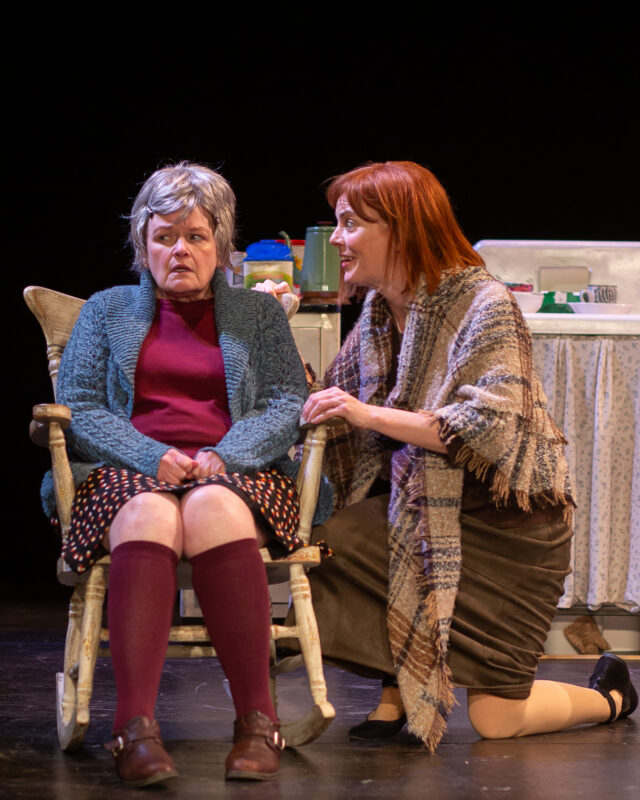When Einstein oncology nurse Liz Kerr sat down to write an ambitious three-act play about 57 Irish railroad workers and two women buried in a deep mass grave not far from the tracks in East Whiteland Township, she had an unusual muse. It was the ghost of young John Ruddy, believed to have been savagely murdered by nativists who wrongly blamed the Irish for bringing cholera to a nearby town near the worksite now known simply as Duffy’s Cut.
Those forlorn immigrants perished – many presumably succumbing to cholera, but others with evidence of physical violence – just a few months after their arrival in the port of Philadelphia in June 1832. No one back home ever knew what had happened to them.
The play is titled, simply, “Duffy’s Cut.” It will be performed as a staged reading by the Irish Heritage Theater Saturday, Oct. 26, from 2 to 5 p.m. at the Commodore John Barry Arts and Cultural Center (the Irish Center) in Mt. Airy.
To Liz Kerr, the play is much more than a historical recollection. It’s a ghost story, but with ramifications extending to the present day. “This is a story of what can happen to immigrants. Next thing you know, people are getting killed. People in that little village who attacked them were so whipped up. This can happen when you start with prejudice against others.”
Ruddy’s skeletal remains were discovered, along with several others in 2012, in a project led by twin brothers Frank Watson, a Lutheran minister, and William, a professor of history at Immaculata. The site is named after Philip Duffy, himself an Irish immigrant, who hired the workers to excavate the challenging landscape to flatten it in preparation for tracks—or, as one historical retrospective put it, “to move a hill into a valley.” Hard labor, indeed.
The deaths remained a secret for decades, until the Watsons first uncovered the mystery in some papers belonging to Joseph Tripican, the Watsons’ grandfather, a secretary to a former Pennsylvania Railroad president. With permission from Amtrak, excavation at the site began in August 2004, with the first bones discovered in March 2009.
Kerr’s husband Pearse, an Amtrak electrician, was a volunteer on the project to excavate the site. One treasured memento of the dig was one of the nails from Ruddy’s coffin, which the Kerrs keep in a box on the fireplace mantle in their Jenkintown home.
Liz Kerr, who has a master’s in fine arts from Arcadia University, says she first crafted a mental outline of the play about two years ago. The dozens of victims of Duffy’s Cut were never far from her mind. And she kept that cherished box on her writing desk for inspiration.
“And then I took a week off summer a year ago to do the dialogue. Basically, I sat in my writing room and let them talk,” she recalls. “There were times when it wasn’t like I was doing the writing. It was just like I was a court reporter, and they were talking.”
Words would pop into her head, unbidden, words she had never heard before. Pearse, her resident fact checker, would look at a word, and realize it was a slang term from County Antrim. “It wasn’t something I knew. And it’s been like that with the Watsons. You would ask them, what would bring you out into this poison ivy-infested, mosquito-laden area and just dig and search and raise money and keep it all up? And it’s because they have been touched by these spirits, too. It sounds bizarre, but it’s true.”
The first act of the play tracks the arrival of the new Irish immigrants. You get to know them all – all their hopes and aspirations in this strange new land so far from their native Ulster. By Act 2, their fate is sealed.
“Cholera has now struck,” Kerr explains. “There’s that presence, that ominous presence coming in. They’re being blamed. And at the end of that act, local townspeople are taking matters into their own hands. That’s when you realize that they’re coming in with the intention to kill them.”
The ghost of John Ruddy has his own part to play in Act 3.
“It’s a soliloquy by John Ruddy, this kid who just wants to go home. He’s watching things happen. The volunteers who worked on this project have always felt his presence there. And then they realize it’s John Ruddy.”
It’s Ruddy, who watches as expertise is brought to bear in the search—the forensic dentist who identifies the missing molar that proves key to identifying Ruddy’s remains. The ground-penetrating radar used to uncover other bones and artifacts—like the broken clay pipe marked with the name of County Derry and “Erin Go Bragh.”
And at the end, Ruddy’s remains are returned to a donated grave in the village of Adara in County Donegal.
That this play is getting an airing at all Kerr credits to the renowned Irish Philadelphia publican Fergus Carey, owner of Fergie’s Pub on Sansom Street, who connected her with Kirsten Quinn, actor and casting director for the Irish Heritage Theatre. And Quinn was intrigued enough to want to present the play.
“I had to put myself where I could meet people,” Kerr says. “Nothing’s going to happen to me working in an inner-city Philly hospital. The theatre world doesn’t come to the oncology unit of Einstein. I don’t work in that world. So, sometimes, you just have to go and talk to people. Fergie is the connection to anything having to do with theatre, poetry and music. If you want to make connections, you have to go there.”
Also joining the presentation will be local Irish musician Matt Ward, who will play tin whistle during the show – and also connected through a friend, Kevin McCloskey, who has performed ballads at Fergie’s.
Ultimately, Ker believes, this is a story that simply had to be told.
“I love a story where people can come back and talk. One of my favorite plays is “Our Town.” Maybe it ties into salvation and life after death, but I just love that kind of story.”A reception with refreshments will follow thew staged reading. A donation of $20 is requested to support The Irish Heritage Theatre. Tickets are available online at www.theirishcenter.org on the events page.



